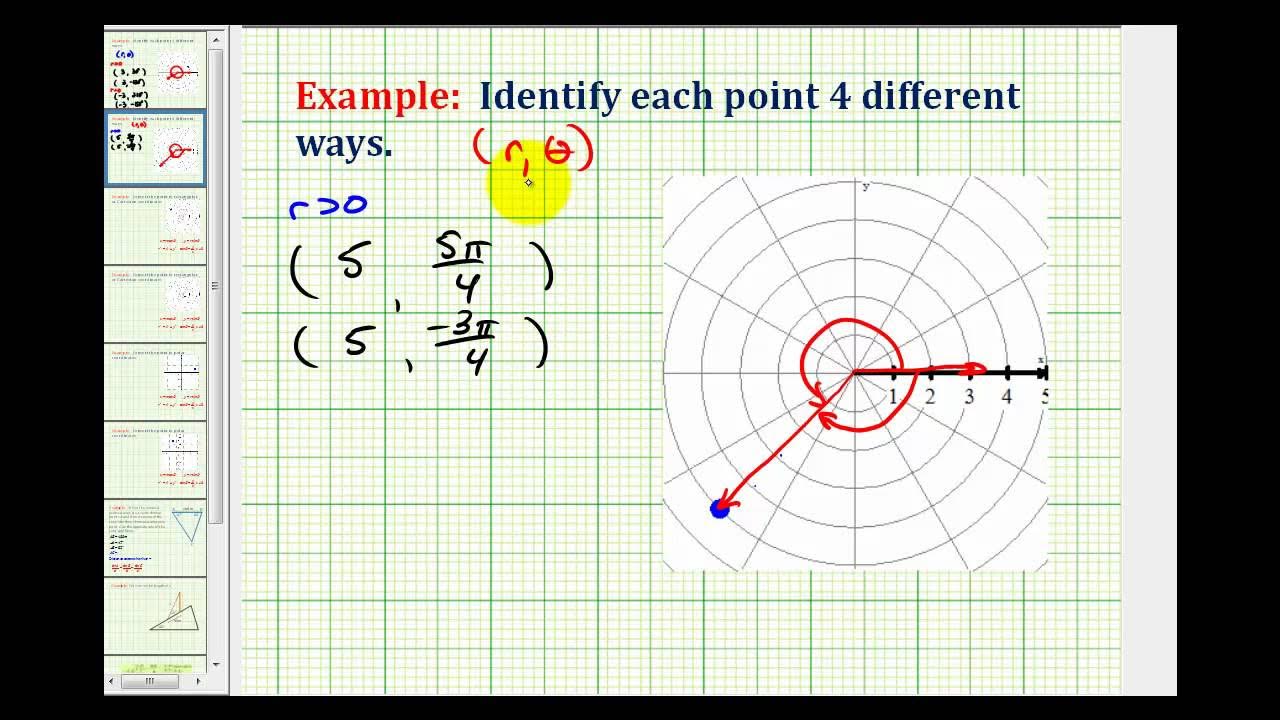Converting Rectangular to Polar Coordinates and Vice Versa (Tagalog/Filipino Math)
Summary
TLDRThis video provides a detailed guide on converting rectangular coordinates to polar coordinates and vice versa. It covers key formulas, including how to calculate the radius (r) and angle (θ) using inverse tangent and the Pythagorean theorem. Through clear examples, viewers learn how to perform these conversions, considering different quadrants and angles. The video also demonstrates practical applications of these formulas, reinforcing the understanding of polar and rectangular coordinate systems for solving mathematical and geometric problems.
Takeaways
- 😀 Converting between rectangular and polar coordinates is a key concept in mathematics and geometry.
- 😀 Rectangular coordinates are given as (x, y), while polar coordinates are represented as (r, θ), where r is the radius and θ is the angle.
- 😀 To convert from rectangular to polar coordinates, use the formulas: r = √(x² + y²) and θ = arctan(y/x).
- 😀 For polar to rectangular conversion, use the formulas: x = r * cos(θ) and y = r * sin(θ).
- 😀 Polar coordinates can describe points in all four quadrants, with θ ranging from 0 to 2π.
- 😀 When converting rectangular coordinates to polar, be mindful of the quadrant, as this affects the angle θ.
- 😀 The angle θ is determined using arctan(y/x), but adjustments are needed based on the quadrant to ensure the correct angle is used.
- 😀 The range of θ is typically between -π and π when using polar coordinates, but for the standard form, θ ranges from 0 to 2π.
- 😀 Examples were provided to illustrate the conversion process, such as converting (√3, 3) to polar coordinates as (2√3, π/3).
- 😀 When working with negative values in rectangular coordinates, adjustments in the angle (θ) are made to ensure the correct polar coordinates are found, such as using 2π - arctan(|y/x|) when in the second quadrant.
Q & A
What is the main focus of the video?
-The video focuses on explaining how to convert rectangular coordinates to polar coordinates and vice versa. It covers formulas, methods, and examples for better understanding.
How is the conversion from rectangular coordinates to polar coordinates achieved?
-The conversion from rectangular coordinates (x, y) to polar coordinates (r, θ) is done using the following formulas: r = √(x² + y²) and θ = arctan(y/x).
What is the formula to calculate the radius (r) in polar coordinates?
-The radius (r) is calculated using the Pythagorean theorem: r = √(x² + y²), where x and y are the rectangular coordinates.
What is the formula to find the angle (θ) in polar coordinates?
-The angle (θ) is found using the inverse tangent: θ = arctan(y/x). In some cases, you may need to adjust θ based on the quadrant the point lies in.
How is the angle (θ) adjusted when converting from rectangular coordinates to polar coordinates?
-The angle (θ) may be adjusted depending on the quadrant in which the point lies. For example, if the point is in the second or third quadrant, θ may need to be adjusted by adding or subtracting π or 2π.
Why is the range of r always greater than or equal to zero in polar coordinates?
-In polar coordinates, r represents the distance from the origin. Since distance cannot be negative, the range for r is always r ≥ 0.
What is the significance of the polar axis in the polar coordinate system?
-The polar axis acts as the reference direction, typically corresponding to the positive x-axis in rectangular coordinates. It defines the initial angle (θ = 0) and helps to determine the orientation of other angles in the polar system.
How do you convert from polar coordinates back to rectangular coordinates?
-To convert from polar coordinates (r, θ) to rectangular coordinates (x, y), you use the formulas: x = r * cos(θ) and y = r * sin(θ).
What does the example of converting (√3, 3) to polar coordinates demonstrate?
-The example demonstrates how to apply the formula to convert rectangular coordinates (√3, 3) to polar coordinates. After applying the formulas, the result is approximately (2√3, π/3).
How do you handle negative coordinates when converting to polar coordinates?
-When the coordinates are negative, you adjust the angle (θ) to reflect the correct quadrant. For example, for coordinates like (2, -2), the angle θ is adjusted to 7π/4 to account for the point's location in the fourth quadrant.
Outlines

このセクションは有料ユーザー限定です。 アクセスするには、アップグレードをお願いします。
今すぐアップグレードMindmap

このセクションは有料ユーザー限定です。 アクセスするには、アップグレードをお願いします。
今すぐアップグレードKeywords

このセクションは有料ユーザー限定です。 アクセスするには、アップグレードをお願いします。
今すぐアップグレードHighlights

このセクションは有料ユーザー限定です。 アクセスするには、アップグレードをお願いします。
今すぐアップグレードTranscripts

このセクションは有料ユーザー限定です。 アクセスするには、アップグレードをお願いします。
今すぐアップグレード関連動画をさらに表示

Polar Coordinates Basic Introduction, Conversion to Rectangular, How to Plot Points, Negative R Valu

Coordenadas Polares ¿Qué son? EXPLICACIÓN COMPLETA

Example: Identify 4 Possible Polar Coordinates for a Point Using Radians

TRIGONOMETRI (Konversi Koordinat Kutub Ke Koordinat Kartesius)

Matematika SMA - Trigonometri (6) - Koordinat Polar, Koordinat Kutub dan Kartesius (A)

Fisika Matematika : Sistem Koordinat Bola
5.0 / 5 (0 votes)
